Stargate (film)
8 /10 2 Votes
Duration | 7/10 IMDb Genre Action, Adventure, Sci-Fi | |||||||||||||||||||||||||||||||||
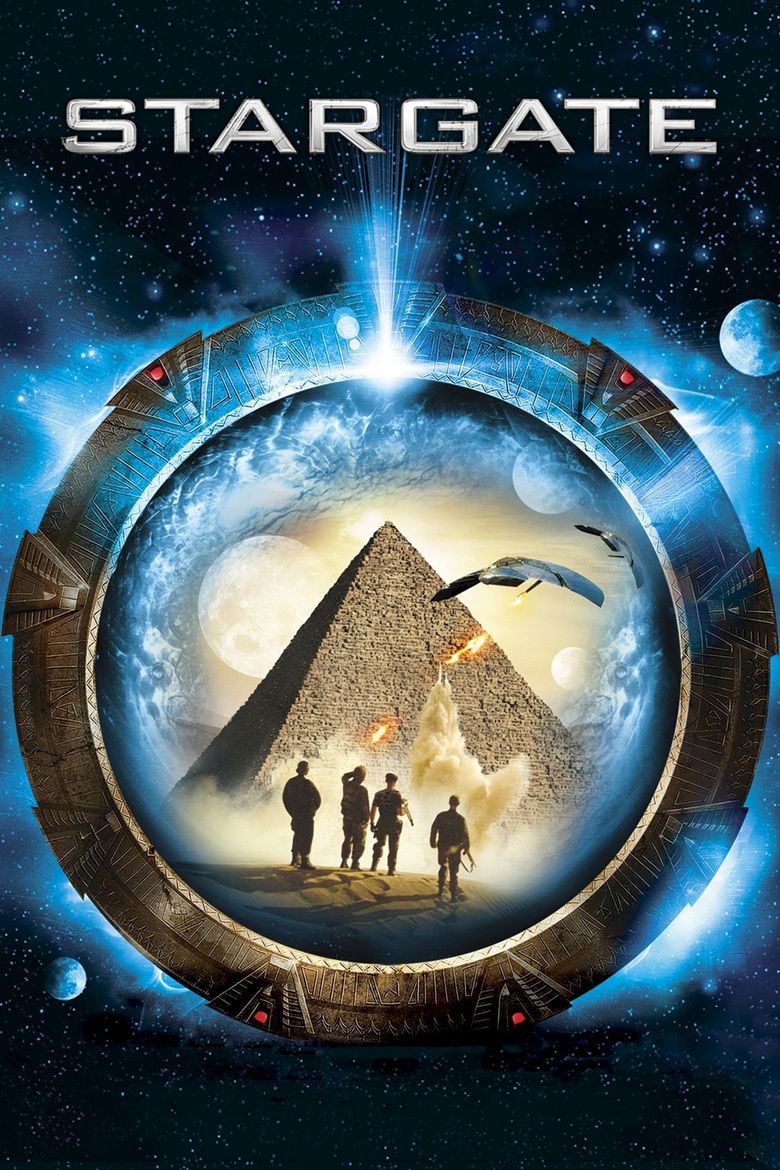 | ||||||||||||||||||||||||||||||||||
Release date October 28, 1994 (1994-10-28) Cast (Colonel Jonathan O'Neil), (Dr. Daniel Jackson), (Skaara), (Catherine), (Sha`uri), (General West) Similar movies Tagline It will take you a million light years from home. But will it bring you back? | ||||||||||||||||||||||||||||||||||
In modern-day Egypt, professor Daniel Jackson (James Spader) teams up with retired Army Col. Jack ONeil (Kurt Russell) to unlock the code of an interstellar gateway to an ancient Egypt-like world. They arrive on a planet ruled by the despotic Ra (Jaye Davidson), who holds the key to the Earth travelers safe return. Now, in order to escape from their intergalactic purgatory, Jackson and ONeil must convince the planets people that Ra must be overthrown.
Contents
- Plot
- Directors cut
- Cast and characters
- Development
- Filming
- Visual effects
- Music and soundtrack
- Release
- Critical reception
- Box office
- Performance analysis
- Awards
- Future
- Sequels
- Television spin offs
- Differences from the series
- Reboot
- References
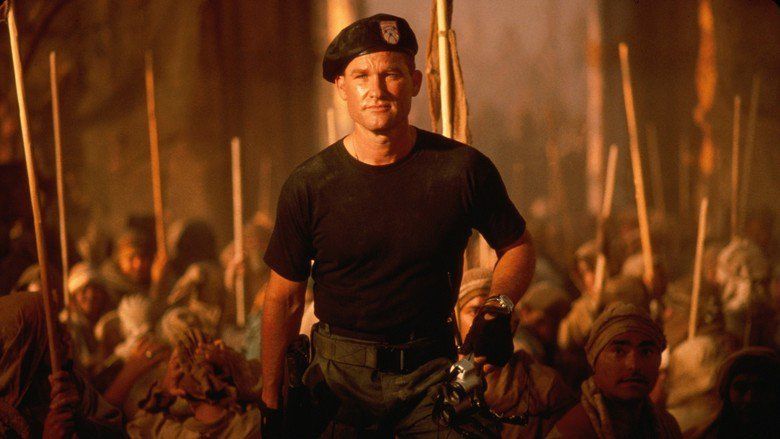
Stargate (French: Stargate, la porte des etoiles) is a 1994 French-American adventure science fiction film released through Metro-Goldwyn-Mayer (MGM) and Carolco Pictures. Created by Dean Devlin and Roland Emmerich, the film is the first release in the Stargate franchise. Directed by Roland Emmerich, the film stars Kurt Russell, James Spader, Jaye Davidson, Alexis Cruz, Mili Avital, and Viveca Lindfors. The plot centers on the premise of a "Stargate", an ancient ring-shaped device that creates a wormhole enabling travel to a similar device elsewhere in the universe. The films central plot explores the theory of extraterrestrial beings having an influence upon human civilization.

The film had a mixed initial critical reception, earning both praise and criticism for its atmosphere, story, characters, and graphic content. Nevertheless, Stargate became a commercial success worldwide. Devlin and Emmerich gave the rights to the franchise to MGM when they were working on their 1996 film Independence Day, and MGM retains the domestic television rights. The rights to the Stargate film are owned by StudioCanal, with Lions Gate Entertainment handling most distribution in international theatrical and worldwide home video releases, although Rialto Pictures handles domestic distribution under license from StudioCanal.
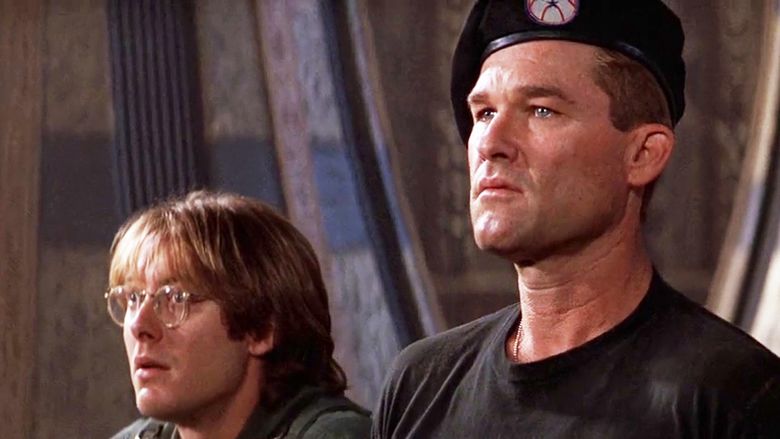
An interstellar teleportation device, found in Egypt, leads to a planet with humans resembling ancient Egyptians who worship the god Ra.
Plot
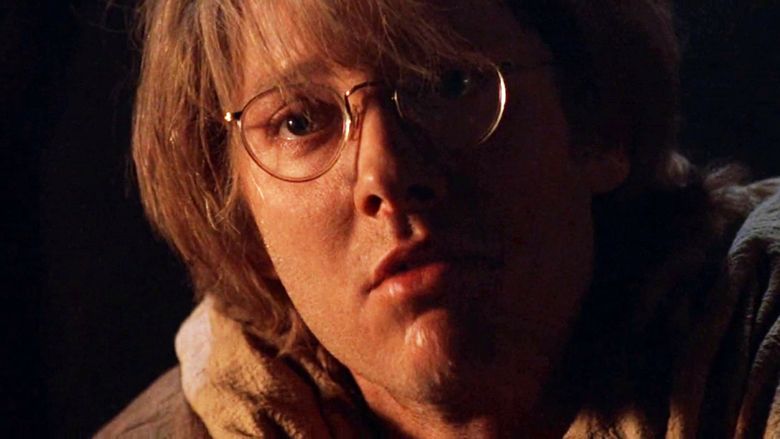
A massive metal ring with engraved cover stones is discovered in the sands of Giza, Egypt in 1928, by an archaeologist named Langford and his young daughter, Catherine. Much later, the elderly Catherine Langford offers Egyptologist and linguist Daniel Jackson the chance to translate the Egyptian hieroglyphs on the cover stones. Jackson accepts and travels to a US Air Force installation where he examines the stones. Special Operations Colonel Jack ONeil arrives to take command of the project and he declares it "classified" before Jackson can begin his research.

Jackson deduces from the hieroglyphs the existence of a "stargate", a device used to travel to distant worlds. He discovers that the accompanying non-hieroglyphic symbols are star constellations used in a three-dimensional coordinate system. When selected in sequence on the metal ring, they create a stable wormhole to some other place in the galaxy. ONeil leads a team with Jackson through the Stargate, and they find themselves inside a pyramid in the middle of a desert. The team cannot return home because the necessary coordinates are missing. Jackson, ONeil, and the others explore the surrounding area and discover a mining operation run by humans. The miners assume that they are emissaries of their god Ra.
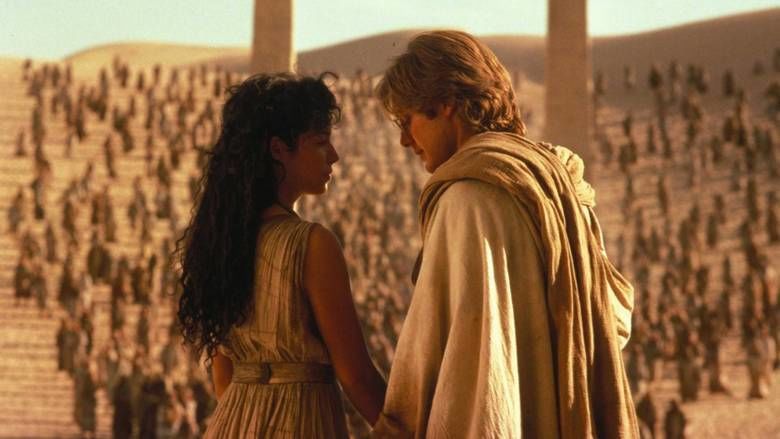
Jackson attempts communication with the locals using pantomime, and later realizes that they speak a modern dialect derived from Ancient Egyptian. The soldiers develop a friendship with local teenager Skaara and his friends, and Jackson is given the chieftain Kasufs daughter Shauri as a gift. He initially rebuffs her, unaware that she is meant to be his wife, but they develop a friendship that blossoms into romance. Jackson guesses that Shauri may know the location of the cartouche containing the return coordinates for the Stargate. Jackson learns that the Egyptian god Ra was an alien lifeform who came to Earth seeking a cure for his impending death. Ra discovered that he could maintain a simpler Human body indefinitely, and he "possessed" the body of a human youth, enslaved the youths people and transported some of them to another planet to mine the mineral on which all of his technology is based. The enslaved Humans on Earth eventually rebelled and expelled Ra, and buried the Stargate. Fearful of a similar rebellion on this planet, Ra outlawed reading and writing so the people would forget their origins. Jackson discovers six symbols of the return coordinates but the seventh symbol is missing.

At night, a pyramid shaped spacecraft descends over the pyramid. Returning to it the following morning, ONeil and Jackson are captured and taken to Ra, who appears to be an androgynous human youth with glowing eyes. Ra reveals his intention to return to Earth an atomic bomb brought by ONeil, its destructive power now enhanced 100-fold with the addition of the mined mineral. ONeil tries to disarm the guards and kill Ra, but Jackson is killed and ONeil and his team are imprisoned. Jackson is regenerated in a sarcophagus-like device and meets with Ra. Ra states that he will kill Jackson and everyone who has seen him unless Jackson kills the rest of the team to remind Kasufs people that Ra is their true god.
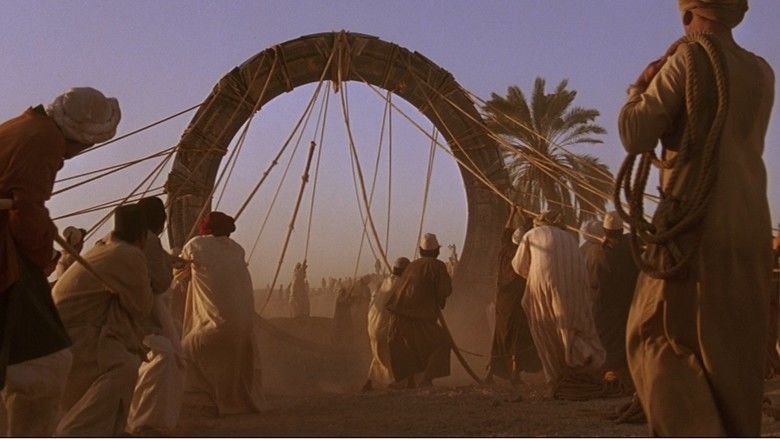
Once Ra has the local people gathered before the pyramid, Skaara and his friends create a distraction while Jackson turns one of the guards weapons on Ra. In the confusion, Jackson and ONeils team escape and take shelter in a cave with Skaara and the others. The next morning, Skaara draws a picture of the victory against Ra, and Jackson realizes that Skaara has drawn the seventh symbol needed to reactivate the Stargate.
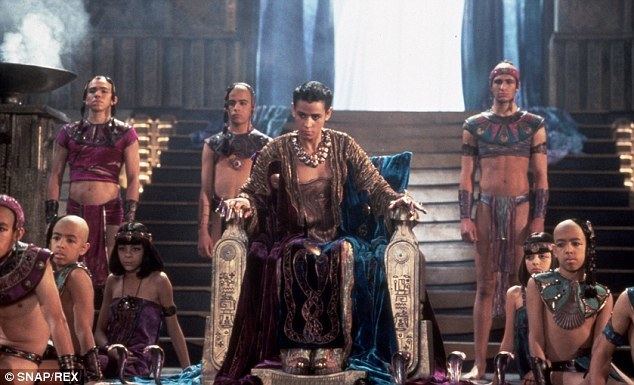
ONeil and Skaaras group attack and overpower the overseers of the mine and convince the people that their "gods" are human. With their help, ONeils team return to the Stargate to deactivate the bomb. Faced with open rebellion, Ra prepares his ship to leave and launches fighters to counter-attack. Shauri is killed in the battle, but Jackson takes her into the ship and resurrects her in Ras sarcophagus device. Ra orders the augmented bomb be sent to Earth immediately. Ras guard captain discovers ONeil, and they fight. Jackson and Shauri are captured by Ra, but ONeil overpowers the guard and activates a teleportation device. The beam decapitates the guard captain and sends the head to Ra, while retrieving Jackson and Shauri. As Ras craft escapes the planet, ONeil and Jackson teleport the bomb to Ras ship. The bomb detonates, killing Ra and destroying the ship. Skaaras people celebrate their freedom and Jackson decides to remain on the planet with Shauri. ONeil and the survivors of his team return to Earth.
Directors cut

The Directors cut had several scenes which were cut from the theatrical film version. The first such scene took place immediately after the excavation of the Stargate in 1928 and showed petrified Horus guards near the cover stones; the producers had tried to introduce the idea that beings had attempted to come through the Stargate after its burial, but they cut the scene for time concerns.
Cast and characters
Development
The film was originally planned to play out in a chronological order, but when Devlin and Emmerich edited the film to tighten the narrative, they decided to change the first scene of the film into a flashback to show who the human host of Ra was before the aliens took him. Only Jaye Davidsons upper torso was filmed because Davidson had refused to take out his nipple rings. The first scene was a combination of model shots and a set in Yuma, Arizona where Rambo: First Blood Part II had been filmed. The scene of the excavation of the Stargate was also filmed in three days in Arizona. A golden look was achieved by filming near the time of sunset. To keep within the limit of the budget, the producers put stick figures with cloth in the distant desert to appear as humans. The original Stargate was painted black, but it looked like a giant tire so it was repainted silver at the last moment.

Daniel Jacksons lecture on his theories was filmed in a hotel in Los Angeles. The scene was originally much longer and delved more into the theories that aliens had built the Egyptian pyramids, but the scene was trimmed for time concerns for the release. The scenes with ONeil at his house were the first scenes filmed with Kurt Russell; his hair was cut short afterwards. Russell requested his hair color to be brightened a little for the film. The fictional facility housing the Stargate was the largest set for the film, located in Long Beach, California. Egyptologist Stuart Tyson Smith joined production to make all Ancient Egyptian hieroglyphics and spoken language as accurate as possible.
Filming
The mask of the pharaoh in the opening credits was made out of fiber glass and modeled in the workshop. The sequence used a motion-control camera to give better depth of field. The score of Stargate was composer David Arnolds first work on an American feature film. When Devlin and Emmerich first flew to London to meet with Arnold, they had not yet heard the score; hearing it, they felt "he had elevated the film to a whole other level". Arnold later interviewed the actors during principal photography, using the information to improve his score.
Visual effects
Jeff Kleiser and Kleiser-Walczak Construction Co.s visual effects team of 40 people created the look of the Stargate. They used self-written image-creation and compositing software, as well as commercial digital packages to create the Stargate, the morphing helmets worn by Ra and the Horus guards, and the cityscape of Nagada. Footprints in the sand were often digitally removed. The creation of the wormhole, which was fully digital, was one of the biggest challenges in the making of the film. The ripples had to be digitally composited to appear accurate and realistic. Scanning lasers were lined up parallel to the gate to illustrate the amount of body that passed the surface of the Stargate plane. Afterwards, the parts of the body that had or had not yet gone through the gate (depending of the side of filming) were obliterated with a digital matte - a process that removes unwanted components from an individual frame or sequence of frames. The use of computers generating a big 3D storyboard allowed Emmerich to try out different shooting angles before settling on one angle.
Music and soundtrack
The soundtrack was composed by David Arnold, played by the Sinfonia of London and conducted by Nicholas Dodd. It was the second motion picture Arnold had composed and the first major motion picture. At the time of Stargates production, David Arnold had recently started to work in a local video store in London. Once Arnold got the job, he spent several months in a hotel room working on the soundtrack, spending more time rewriting the music and improving it as delays were being created due to film companies trying to get the rights to release the film. According to Arnold "when I first read the script for StarGate, I knew what approach to take, which was to be as big and bold as possible," he kept on saying:
Release
The film was released on October 28, 1994 in the United States and released internationally in December of the same year. In 1995 the film was released on VHS and as a Dolby Digital encoded laserdisc spanning two discs (three sides). The first DVD release was on June 18, 1997. The DVD format was re-released in October 1999 under the title Stargate Special Edition. The film was released on Blu-ray format on August 29, 2006.
Critical reception
Stargate has garnered mostly mixed reviews. In the Rotten Tomatoes main "T-Meter Critics" section, 48% of critics gave the film a positive review based on 40 reviews, with an average rating of 5.3 out of 10. At MRQE, which assigns a normalized rating out of 100 from most critics, the film holds a score of 64 based on 95 reviews. Out of Emmerichs 22 works, Stargate is his 3rd highest rated film.
Most of the negative reviews focused on the overuse of special effects, thinness of plot and excessive use of cliches with Roger Ebert going so far as to say, "the movie Ed Wood, about the worst director of all time, was made to prepare us for Stargate". Ebert awarded the film one out of four stars, and even over ten years later Stargate remained on his list of most hated films. Mike DiBella from AllMovie said, "there simply isnt enough spectacle in Stargate to make up for its many flaws." The film peaked at number one on the Billboard chart Top Video Rentals on April 29, 1995. However the positive reviews stated that it was an "instant camp classic", and praised the film for its special effects and entertainment value, with Chris Hicks of the Deseret News calling it "Star Wars meets Ben Hur". Scott McKenzie from DVD active said this about the film "its a shame because the world created around the Stargate is compelling and detailed. Its almost enough to make me want to watch the TV series, but not quite." After the release of the movie, Emmerich and Devlin were sued by an Egyptology student, claiming he had written the story and given them the idea. The suit was later settled out of court.
Box office
The film received a warmer reception from the public, grossing $71.5 million at the US box office and $125 million in the rest of the world. At the time, the film set a record for the highest-grossing opening weekend for a film released in the month of October.
Performance analysis
In its first run, Stargate made more money than film industry insiders predicted, especially given its lukewarm reviews. Some regard it as Emmerichs breakthrough film. Stargate grossed over $16,651,000 in the United States during its opening week in October 1994. It was the 35th highest-grossing film opening in the US in October. From November 4–6, the film grossed around $12,368,700, declining 25%. The film would continue this decline until the end of November, when the film garnered $4,777,198, or an 8.2% rise. The week before that the film garnered around $4,413,420, a 45.6% decline. In its last week playing theatrically, the film garnered around $1,170,500 in the US.
Awards
In 1995, Stargate was considered for various film awards worldwide. It won six of the ten awards it was nominated for.
Future
Dean Devlin and Roland Emmerich always envisioned Stargate as the first part of a trilogy of films, but parts two and three were never developed. At Comic-Con 2006, 12 years after the original film was released, writer/producer Dean Devlin stated that he was in early discussions with rightsholders MGM about finally bringing the final two parts to the screen.
Sequels
According to Devlin, the second film is intended to be set around 12 years after the original, with Daniel Jackson making a discovery that leads him back to Earth and to the uncovering of a new Stargate. The second movie would supposedly use a different mythology from the Egyptian one which formed the background to the original movie, with the third movie tying these together to reveal that "all mythologies are actually tied together with a common thread that we havent recognized before." Devlin stated that he hoped to enlist original stars Kurt Russell (Col. Jack ONeil) and James Spader (Dr. Daniel Jackson) for the sequels. The actors have reportedly expressed an interest in participating in the project.
The film trilogy would not directly tie into the Stargate SG-1 series. According to Devlin, the relationship between the movie and the series is "we would just continue the mythology of the movie and finish that out. I think the series could still live on at the end of the third sequel. So were going to try to not tread on their stories." Plans for sequels to the original film are unrelated to the development of straight-to-DVD movies made as sequels to Stargate SG-1. Using some of Roland Emmerichs notes, Bill McCay wrote a series of five novels, continuing the story the original creators had envisioned, which involved the Earth-humans, the locals and the successors of Ra. According to Devlin, he and Emmerich had always planned to do three films with the potential for more, but MGM preferred to play out the television series first.
Television spin-offs
The CD ROM Secrets of Stargate, released after the film, shows how the special effects were made. The film included behind the scenes of the film and the showing interviews with the cast and the production members. Dean Devlin eventually gave Metro–Goldwyn–Mayer (MGM) the rights over the film, and author Bill McCay wrote a series of five novels based on Emmerichs notes, continuing the story the original creators had envisioned. In 1996, MGM hired Brad Wright and Jonathan Glassner to create a spin-off television series. Stargate SG-1 premiered on the American subscription channel Showtime on July 27, 1997 and ended its ten-season run in 2007. Stargate SG-1 itself spawned the non-canon animated television series Stargate Infinity (2002–2003), and the live-action television series Stargate Atlantis (2004–2009) and Stargate Universe (2009–2011).
Differences from the series
SG-1 creators and executive producers Brad Wright and Jonathan Glassner altered the canon by introducing several new concepts during production of the SG-1 and Atlantis series. Most notably, many characters were portrayed by different actors in the series, and names were spelled differently. Daniel Jackson was played by James Spader in the movie and by Michael Shanks in the series. Kurt Russells character Jonathan "Jack" ONeil, a rather humorless Colonel, is played by Richard Dean Anderson as Jonathan "Jack" ONeill (with two Ls) in SG-1. French Stewarts character was named Lieutenant Louis Ferretti, in SG-1, Brent Staits character is named Major Louis Ferretti. The spelling of Daniel Jacksons wife changes from Shauri to Share, ONeills wife from Sarah to Sara, (similarly, the name of ONeils son changes from Tyler in the film to Charlie).
The Stargate Command setting was transferred from the fictional military facility located in Creek Mountain, to the Cheyenne Mountain military complex. The unnamed planet from the film was named Abydos in the series and the distance from Earth changed from millions of light-years away (in an entirely different galaxy, "the Kalium galaxy") to becoming the closest planet to Earth with a Stargate, residing in the same galaxy as Earth. Also in SG-1, Stargate travel is limited to the Stargate network in the Milky Way galaxy (unless a tremendous amount of power is used to lengthen the subspace wormhole of a Stargate to another galaxys Stargate). Ra was the last of an unnamed race in the film, being of a humanoid species with large black eyes and a lack of facial features. In SG-1 however, Ra is one of many "Goauld System Lords," who are a race of parasitic eel-like creatures. There were also changes to the Stargate. The unique set of 39 Stargate symbols in the film were replaced with the concept of 38 symbols that are the same for each Stargate (Earths symbols based on Earths constellations), plus a single point of origin symbol that is unique to that individual gate. While the kawoosh effect in the movie was created by filming the actual swirl of water in a glass tube, and looked like a vortex on the back of the Gate; on the TV series this effect was completely created in CG by the Canadian visual effects company Rainmaker. At the beginning of Season 9, the original movie wormhole sequence was substituted by a new sequence similar to the one already used on Stargate Atlantis, but being blue as it was in the movie and SG-1, whereas in Atlantis its green.
Reboot
On September 5, 2013, during an interview with Digital Spy, Emmerich said that he and MGM are planning a new Stargate as a reboot with a trilogy. On May 29, 2014, it was announced that MGM andWarner Bros. are partnering together for a reboot of Stargate as a trilogy with Emmerich directing, Devlin producing and Nicolas Wright & James A. Woods writing.
References
Stargate (film) WikipediaStargate (film) IMDb Stargate (film) themoviedb.org
